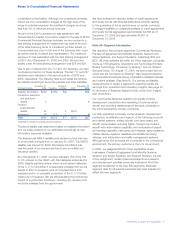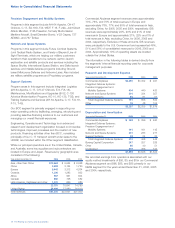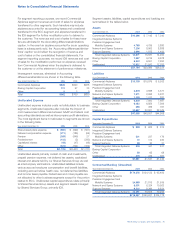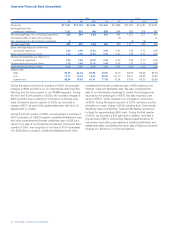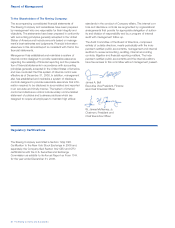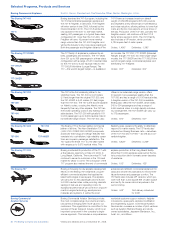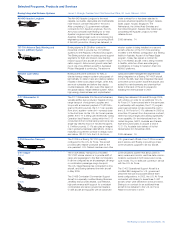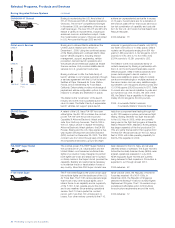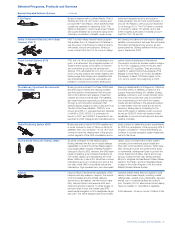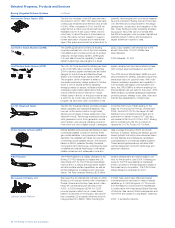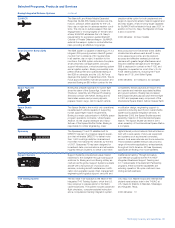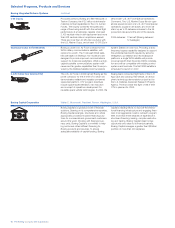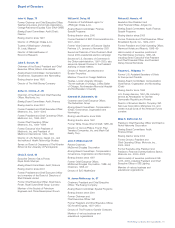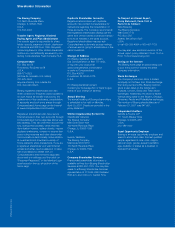Boeing 2006 Annual Report Download - page 89
Download and view the complete annual report
Please find page 89 of the 2006 Boeing annual report below. You can navigate through the pages in the report by either clicking on the pages listed below, or by using the keyword search tool below to find specific information within the annual report.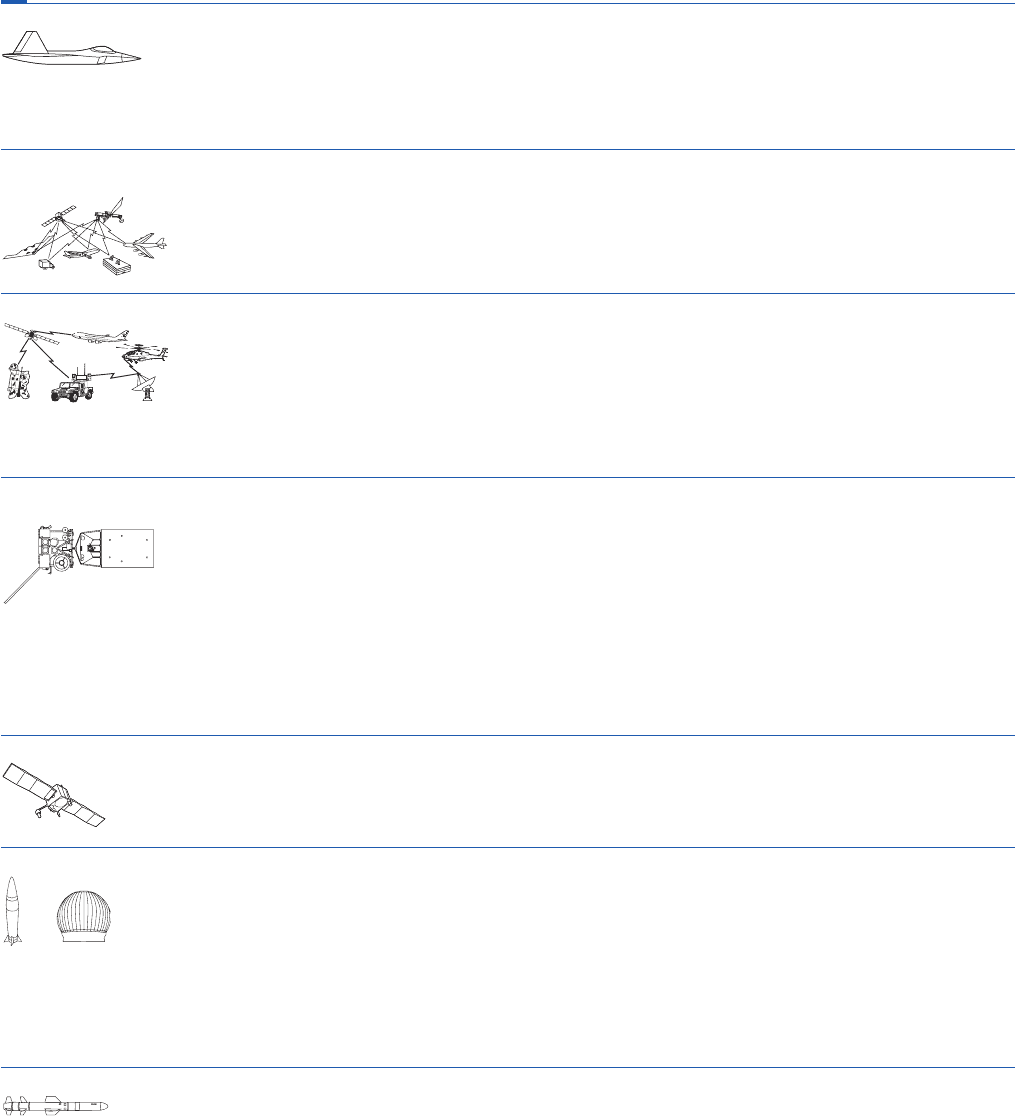
Future Combat Systems (FCS) FCS, the U.S. Army’s premier modernization pro-
gram, is a networked, fully integrated system-of-
systems that includes a new family of manned
and unmanned ground and air vehicles and
sensors. FCS will enable the U.S. Army modular
force, providing soldiers and military leaders with
leading-edge technologies and capabilities that
will dramatically increase their survivability and
lethality in complex environments. Boeing and
partner Science Applications International
Corporation function as the lead systems integra-
tor for FCS, managing a best-of-industry team
of more than 630 suppliers. They are working
together to deliver the first fully-equipped FCS
Brigade Combat Team in 2014 and accelerate
the delivery of select FCS technologies to the
U.S. Army’s current force beginning in 2008.
Geostationary Operational Environmental
Satellites (GOES)
Boeing is prime contractor for three GOES satel-
lites that support NASA and National Oceanic
and Atmospheric Administration (NOAA) scien-
tists in the collection and analysis of real-time
weather and environmental data. The satellites
also assist rescuers responding to distress calls
through a communication subsystem that
detects distress signals on land, at sea and in air.
The first of the three satellites, GOES-N, now
known as GOES-13, was launched and delivered
to NASA in 2006. GOES-O is scheduled for
launch in 2007, and GOES-P is expected to be
launched in 2008. Designed and manufactured at
Boeing’s satellite facility in El Segundo, California,
the GOES series of satellites is based on the
popular three-axis Boeing 601 satellite. Boeing
satellites continue to work toward NOAA’s vision
of an informed society that uses a comprehen-
sive understanding of the role of the oceans,
coasts and atmosphere in the global ecosystem
to make better, informed social and economic
decisions. Boeing also is competing for the
next GOES series of satellites under a program
known as GOES-R, which will expand current
capabilities to provide more timely and accurate
weather forecasts.
Global Positioning System (GPS) Boeing has built a total of 40 GPS satellites and
is under contract to build 12 follow-on Block IIF
satellites. Also, two contracts—a U.S. Air Force
contract to lead the development of the ground
control segment of the GPS constellation and a
study contract to define the system requirements
for GPS III in anticipation of the upcoming GPS III
program competition—ensure that Boeing will
continue to provide navigation system leadership
well into the future.
Ground-based Midcourse Defense (GMD) As prime contractor for the GMD program,
Boeing delivered the first set of missile defense
capabilities to protect the United States against
long-range ballistic missiles. Meeting President
George W. Bush’s 2002 directive, the GMD team
began emplacing ground-based interceptors at
Fort Greely, Alaska, and Vandenberg Air Force
Base, California, in late 2004. More than a dozen
interceptors are now in underground silos at the
two sites. Initial GMD components include the
interceptors, high-powered land- and sea-based
radars, and a command-and-control system
consisting of an extensive space-based and
fiber-optic communications network. GMD capa-
bility will expand under the government’s spiral,
or incremental, development plan to protect the
United States and its allies, friends and troops
abroad. During the next year, Boeing will lead
efforts to integrate the Sea-Based X-Band Radar,
based in the Pacific, and the Fylingdales Radar,
located in the United Kingdom, into the overall
Ballistic Missile Defense System.
Harpoon Harpoon Block II expands the capabilities of the
Harpoon anti-ship weapon. Harpoon, the world’s
most successful anti-ship missile, features
autonomous, all-weather, over-the-horizon capa-
bility. Harpoon Block II can execute both land-
strike and anti-ship missions. To strike targets on
land and ships in port, the missile uses GPS-
aided inertial navigation to hit a designated target
aim point. The 226.8-kilogram (500-pound) blast
warhead delivers lethal firepower against a wide
variety of land-based targets, including coastal
defense sites, surface-to-air missile sites, exposed
aircraft, port or industrial facilities and ships in
port. Currently, 28 U.S. allied armed forces deploy
Harpoon missiles; 11 have Block II capability.
2006 deliveries: 40 all-up rounds; 19 Block II Kits
Boeing Integrated Defense Systems continued
The Boeing Company and Subsidiaries 87
Selected Programs, Products and Services
F-22A Raptor Boeing is teamed with Lockheed Martin, Pratt &
Whitney and the U.S. Air Force to develop and
produce the F-22A Raptor, which achieved initial
operational capability in December 2005. The
fighter is designed to overcome all known threats
and quickly establish air dominance using its rev-
olutionary combination of stealth, super-cruise,
advanced integrated avionics and superior
maneuverability. The Air Force currently plans to
procure 183 Raptors, with production expected
to run through 2011. The F-22 team is currently
on contract to deliver 131 aircraft, and in late
2006 Congress authorized a multiyear procure-
ment for FY07, 08 and 09.
Family of Advanced Beyond-Line-of-Sight
Terminals (FAB-T)
FAB-T is a key military transformation program
that enables the U.S. Department of Defense to
use the power of technology to strike an enemy
with speed, security and precision. Boeing is
under contract with the U.S. Air Force to design
and develop this family of multi-mission capable,
satellite communications terminals that will enable
information exchange among ground, air and
space platforms. Boeing delivered the first proto-
type in September 2006.


